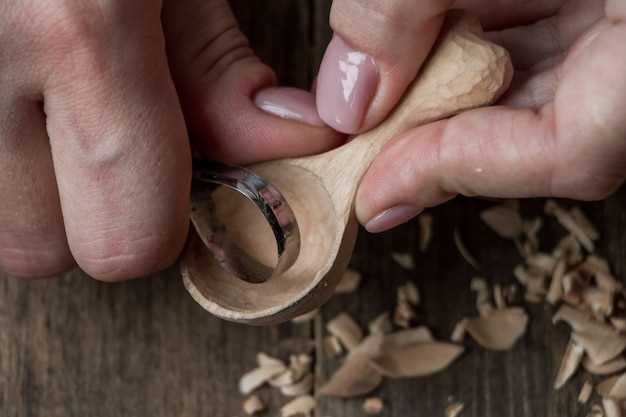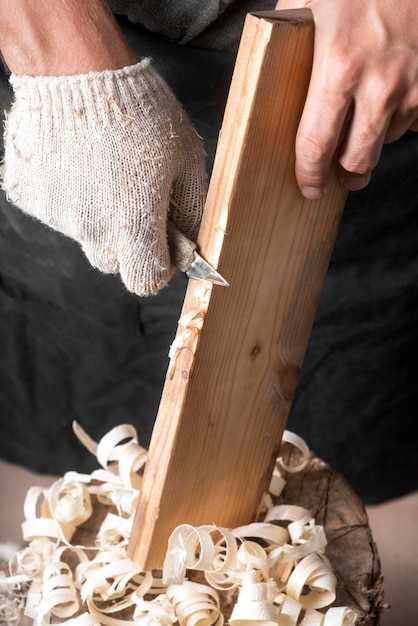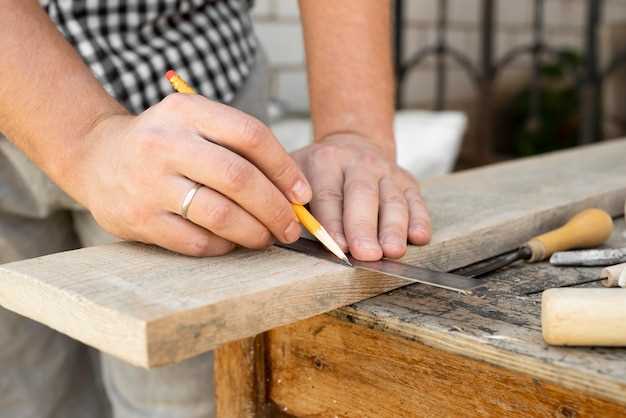Choose your wood wisely. Softwoods like pine and basswood are excellent for beginners due to their ease of carving. Harvested sustainably, these materials minimize environmental impact and offer vibrant textures that enhance your projects. Always look for local suppliers who practice responsible forestry.
Invest in quality tools. A simple set of carving knives, a bench knife, and a carving gouge can set the foundation for your woodworking endeavors. Prioritizing handmade or sustainably sourced tools not only supports artisans but ensures that you’re working with products that are designed to last.
Start with simple projects. Begin with small items like spoons or ornaments to build your confidence. These projects allow you to grasp fundamental techniques and understand your tools better. Share your creations with others to receive constructive feedback and motivation.
Practice consistently. Like any skill, wood carving improves with regular practice. Dedicate time each week to refine your techniques and explore new styles. As you grow, consider incorporating more complex designs that challenge your creativity and skill set.
Connect with the community. Joining local carving clubs or online forums can provide invaluable support. Engaging with experienced carvers through workshops or social media platforms will enhance your learning experience and inspire new ideas while promoting sustainable practices.
Choosing the Right Sustainable Wood for Your Projects

Select carefully from various sustainable wood types available. Look for hardwoods like oak, cherry, or maple that grow in abundant, well-managed forests. These woods offer durability and beauty, making them suitable for intricate carvings and functional items.
Consider Certified Wood Sources
Seek out wood certified by organizations such as the Forest Stewardship Council (FSC). This certification guarantees responsible forestry practices, ensuring protection for the environment and local communities. Supporting certified sources reinforces sustainable management and encourages ethical woodworking.
Local Species for Accessibility and Affordability
Explore local wood species that are native to your area. Using locally sourced wood reduces transportation emissions and supports local economies. Pine, cedar, and poplar are often easily accessible and can be both cost-effective and sustainable choices for beginners.
Eco-Friendly Tools and Equipment for Wood Carving

Choose tools made from sustainable materials, like bamboo or recycled metals. Bamboo carving tools are durable and lightweight, making them perfect for both beginners and experienced carvers. Look for brands that prioritize eco-friendly manufacturing processes.
Hand Tools
Opt for hand tools such as chisels and gouges crafted from recycled steel. These tools offer longevity and can be sharpened multiple times. Seek out manufacturers that support green practices, ensuring that the tools have minimal environmental impact.
Try ergonomic grips made from natural rubber or reclaimed wood. These grips increase comfort during use and reduce fatigue, allowing for longer carving sessions without strain.
Power Tools
If you prefer power tools, select those that boast energy-efficient designs. Look for electric tools with low power consumption and certifications that demonstrate environmental responsibility. Brands focusing on reducing carbon footprints often provide high-quality equipment.
When purchasing larger equipment like lathes or saws, consider their energy ratings and choose models that have efficient motors. These options consume less energy during operation, contributing to a greener workspace.
For organization, utilize storage solutions made from recycled materials. Wooden tool racks or containers sourced from reclaimed wood enhance your workspace while adhering to sustainable practices.
Finally, remember to maintain your tools properly. Regular care and sharpening ensure longevity, reducing the need for frequent replacements and minimizing waste.
Techniques for Minimizing Waste in Wood Carving

Utilize a well-thought-out design before starting your project. Planning your carving can significantly reduce material waste by determining exactly how much wood you need.
Choose smaller projects that require less wood. This approach limits excess material and allows for more intricate detail with the available resources.
Incorporate offcuts into your designs. Small pieces of wood can be transformed into charming keychains, coasters, or smaller carvings, ensuring that no material goes unused.
Use a bandsaw or scroll saw for precision cutting. These tools reduce the amount of wood removed from the initial block, allowing for cleaner cuts and less waste material.
Practice efficient grain orientation. Understanding wood grain can help you cut pieces in a way that maximizes usable space and minimizes undesirable splits and defects.
Save shavings and chips created during the carving process. These byproducts can be used for fuel, mulch, or even as a filler in more extensive projects.
Store and label scrap wood. Organizing offcuts by size and type makes it easier to find the right material for future projects, encouraging re-use rather than disposal.
Educate yourself about wood types and their characteristics. Using woods that are readily available and come from sustainable sources reduces the environmental impact and supports eco-friendly practices.
Experiment with negative space in your designs. This technique allows you to create visually appealing carvings while maximizing the amount of wood used efficiently.
Share your scraps with fellow woodworkers or local schools. This collaboration can encourage creativity in others and minimize waste in your own workspace.
Finding Sustainable Sources for Your Wood Materials

Seek local suppliers who prioritize sustainable practices. Check for businesses that provide certified wood products, such as those certified by the Forest Stewardship Council (FSC) or the Sustainable Forestry Initiative (SFI). These certifications ensure responsible forestry practices that protect ecosystems and promote reforestation.
Explore Reclaimed Wood Options
Consider using reclaimed wood. Salvaged materials from old buildings, furniture, or pallets offer unique character while reducing the demand for new timber. Numerous suppliers specialize in reclaimed wood, allowing you to find quality pieces with history.
Use Sustainable Tree Species
Choose fast-growing tree species like bamboo, poplar, or pine. These types regenerate quickly and offer a sustainable alternative to slower-growing hardwoods. Local lumberyards often carry sustainably sourced native species, further minimizing environmental impact.
| Wood Type | Sustainability Factor | Availability |
|---|---|---|
| Bamboo | Rapid growth rate | Common in specialty stores |
| Pine | Fast-growing, widely available | Local lumberyards |
| Poplar | Decent growth rate, medium durability | Available at most hardware stores |
| Reclaimed Wood | Repurposing materials | Specialty suppliers |
Support local sawmills that practice sustainable harvesting. Build relationships with suppliers who are transparent about their sourcing methods. Your choices not only impact the environment but also support local economies and communities.
Integrating Wood Carvings into Commercial Interior Design
Start with a statement piece. A large wood carving can serve as a focal point in lobbies or waiting areas, drawing attention and sparking conversation. Choose themes that align with your brand identity to create a cohesive atmosphere.
Consider the scale of your furniture and surroundings. Opt for carvings that complement rather than overwhelm the existing design. Smaller wooden accents, like carved wall art or functional items, can enhance the environment without competing for attention.
- Natural lighting: Position wood carvings to catch light and create dynamic shadows, adding depth and warmth to the space.
- Material synergy: Pair wooden elements with metal or stone to achieve a balanced aesthetic. This contrast highlights textures and brings versatility to the design.
- Local craftsmanship: Source carvings from local artisans to support the community and add a unique touch. It emphasizes authenticity and sustainability.
Incorporate wood carvings into functional elements. For instance, carved reception desks or cabinet doors offer artistry while serving practical purposes. This integration enhances usability and elevates design quality.
- Assess existing color palettes. Choose wood tones that harmonize with wall colors and furnishings.
- Implement carvings in themed spaces, such as breakout rooms, using designs that enhance the room’s purpose.
- Rotate art periodically to keep the environment fresh. This practice engages employees and visitors alike.
Install carvings in strategic locations, such as entryways or high-traffic areas, for maximum visibility. Ensure that the pieces are accessible for closer inspection, which encourages appreciation for the craftsmanship.
Consider textures and finishes that resonate with the overall interior design scheme. A matte finish may work well in a rustic setting, while a polished look may suit modern, minimalist designs.
Lastly, promote storytelling through the artwork. Each carving can embody a narrative that connects visitors with the brand’s mission or values, making the experience memorable and engaging.
Creating Eco-Conscious Wood Carving Designs
Choose reclaimed wood for your projects. This not only gives a unique character to each piece but also reduces the demand for new lumber. Look for sources like old furniture, pallets, or leftover construction materials.
- Visit local salvage yards or thrift stores for high-quality reclaimed wood.
- Ask friends and family if they have old items they are willing to part with.
- Consider community wood exchange programs to find materials sustainably.
Incorporate natural motifs into your designs. Nature-inspired patterns resonate with both the woodworking process and the environment. Think about incorporating leaves, animals, or geometric shapes that mimic organic forms.
- Sketch nature scenes or use stencils for detailed carvings.
- Experiment with different textures to reflect various aspects of nature.
Opt for non-toxic finishes and adhesives. Many traditional products contain harmful chemicals that can impact both health and the environment. Select water-based or natural oils that are safer alternatives.
- Explore options like linseed oil, which provides a nice finish without harmful side effects.
- Research eco-friendly sealers that are safe for indoor use.
Educate yourself about local wood species. Familiarize yourself with native trees that grow sustainably in your area. This knowledge helps you choose materials that support local ecosystems.
- Join woodworking clubs or local sustainable forestry workshops to enhance your awareness.
- Keep an eye on local regulations regarding wood sourcing to ensure compliance.
Plan your designs carefully. Create efficient patterns that minimize waste during the carving process. This enhances both your resourcefulness and overall sustainability.
- Use software or apps to simulate designs before you carve.
- Make the most of your wood by considering grain direction and potential defects.
Share your eco-conscious projects. Creating a community of like-minded woodworkers can inspire others to make sustainable choices. Use social media platforms or local art shows to showcase your work.
- Engage in online forums dedicated to sustainable woodworking.
- Host workshops to teach others about eco-friendly practices in wood carving.
Maintaining Your Tools for Long-Term Sustainability
Regularly clean your woodworking tools after each use. Dust and debris can dull blades and compromise performance. Use a soft cloth to wipe down surfaces and a brush to remove any particles from crevices.
Apply a light coat of oil to metal components to prevent rust. Choose a food-safe mineral oil for tools that come in contact with wood. This protects against moisture and maintains the integrity of the metal.
Sharpening Your Blades
Keep your blades sharp to reduce the effort needed during carving. Invest in a quality sharpening stone or system. Hone your tools frequently; doing this every few projects can extend their lifespan significantly. A sharp blade leads to cleaner cuts and minimizes the risk of accidents.
Proper Storage Techniques
Store your tools in a dry environment. Use a dedicated toolbox or a protective case to avoid moisture exposure. Hanging tools on a wall-mounted rack keeps them visible and prevents them from getting damaged. Use sheathes or guards on sharp edges to protect both the tools and yourself.
Regularly inspect your tools for damage. Address any cracks or loose handles immediately to avoid further issues. Taking these preventive measures promotes not just the longevity of your tools, but also safer woodworking experiences.
Showcasing Your Work: Marketing Sustainable Wood Carvings
Utilize social media platforms like Instagram and Pinterest to visually share your wood carvings. Post high-quality photos that highlight the details and craftsmanship of your pieces. Use relevant hashtags such as #SustainableWoodworking, #WoodCarvings, and #EcoFriendlyArt to reach a targeted audience interested in sustainable products.
Participate in local craft fairs and farmer’s markets to connect with customers directly. Setting up a booth allows potential buyers to see your work up close and appreciate the effort you put into each piece. Create informative signage about your materials and the sustainability aspect of your craft to engage visitors.
Engage with online communities focused on woodworking and sustainable living. Join forums, Facebook groups, or Reddit threads where enthusiasts share their creations. Contributing helpful advice or showcasing your work can build trust and attract interest in your products.
Collaborate with local businesses that promote sustainable products. Consider placing your carvings in eco-friendly stores or partnering with artisans who focus on sustainable practices. This not only expands your reach but also aligns your brand with other values-driven entities.
Build your own website to create a digital portfolio. Include an online shop where customers can easily purchase your carvings. Optimize your site for search engines with keywords related to sustainable wood carvings to attract organic traffic. Share blog posts about your techniques, projects, and the benefits of sustainable woodworking to engage visitors.
Offer workshops or classes to teach others about wood carving. This generates interest in your art and establishes you as an expert in the field. Participants may also become customers as they develop an appreciation for the craft.
Consider using email marketing to keep your audience informed about new products, upcoming events, or workshops. A well-structured newsletter can remind subscribers of your work and encourage them to make a purchase.
Show appreciation for customer feedback and testimonials. Encourage satisfied clients to share their experiences and showcase their purchases on social media. User-generated content can serve as powerful endorsements that attract new customers.
Video:
5 Things I Wish I Knew When I Started Woodcarving
5 Things I Wish I Knew When I Started Woodcarving by Alec LaCasse 40,420 views 1 year ago 4 minutes, 49 seconds
Q&A:
What tools do I need to start wood carving as a beginner?
For beginners in wood carving, it’s best to start with a few essential tools. You’ll need a basic set of carving knives, which typically includes a gouge and a chisel. A carving knife with a curved blade is ideal for shaping, while a flat chisel can help with detail work. Additionally, a cutting mat or piece of scrap wood will protect your surfaces. A good pair of safety gloves is also recommended to prevent injuries while working. As you advance, you can expand your toolkit based on your specific interests in carving.
What types of wood are best for beginners in sustainable woodworking?
When starting out in sustainable woodworking, it’s wise to choose softwoods like pine, basswood, or cedar. These types of wood are easier to carve and are often more affordable. Basswood, in particular, is favored by many beginners due to its fine grain and minimal knots. Sustainability is crucial, so look for wood sourced from responsible suppliers or consider reclaimed wood. This not only reduces waste but helps protect forests for future generations.
How can I ensure that my wood carving practices are eco-friendly?
To make your wood carving practices eco-friendly, start by selecting sustainably sourced wood. Research suppliers that prioritize responsible forestry and choose products certified by organizations like the Forest Stewardship Council (FSC). Minimize waste during your projects—save scraps for smaller projects or utilitarian uses. Additionally, use non-toxic finishes and glues, and recycle any materials whenever possible. Being mindful of your tools and techniques can also reduce your environmental impact.
What are some beginner-friendly carving projects I can try?
As a beginner, it’s helpful to start with simple projects that allow you to practice basic techniques. Consider carving a spoon, which is a classic project that teaches you shaping and detailing. Another option is to create small animals or figurines, as these allow for creativity without being overly complex. You might also try making simple decorations like ornaments or coasters. Each of these projects will help you build your skills while also being enjoyable and satisfying.
How long should I expect it to take to become proficient at wood carving?
Becoming proficient in wood carving varies greatly from person to person and depends on the amount of practice you dedicate. Many beginners start to feel comfortable with their tools and techniques within a few months of consistent practice. However, mastering more intricate designs and techniques can take years. It’s important to enjoy the learning process and remember that each project contributes to your growth. Joining a community, either online or locally, can also provide support and accelerate your development.
